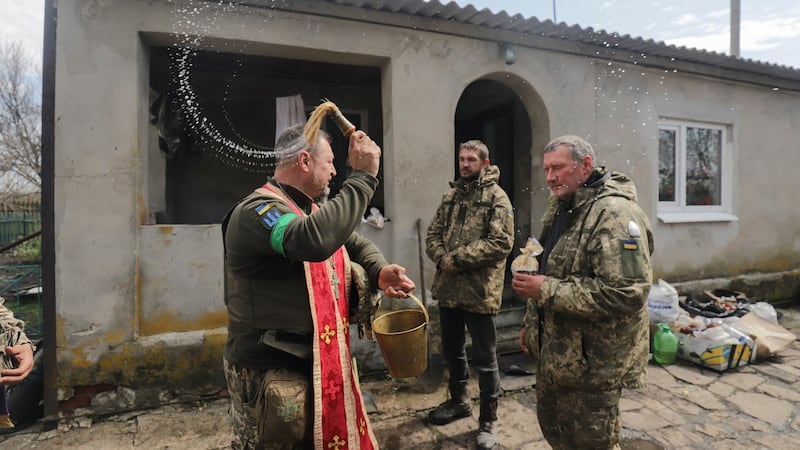On April 19th, after Russia announced it would focus its military efforts on southeastern Ukraine, intensive air strikes and artillery bombardment rained down across the broad arc of the contact line running from Izyum to Mykolayiv.
But the sound and fury have proved a passing spring storm: in the low-level fighting that ensued Russia has slowly ground forward, despite expectations that a more concentrated use of force could tip the conflict in Moscow’s favour after its failed assault on Kyiv.
Much about the war is still hard to read: the combat status of the “Joint Forces Operation” – the Ukrainian army group that concentrates the battle-hardened force deployed in the eastern region of Donbas since the Russian annexation of Crimea in 2014 – is a critical unknown, for example.
What seems clear is that even with a vastly circumscribed set of military objectives – wound back from a plan for the lightning subjugation of the entire country – Russia, a would-be military equal of Washington, is still faltering.
Russia is making “minimal at best progress”, said one senior US defence official. “In some cases, quite frankly, the best word to describe it would be anaemic.”
According to Oleksiy Arestovych, an adviser to Ukrainian president Volodymyr Zelenskiy, Vladimir Putin's revised aim is the total capture of the eastern provinces of Luhansk and Donetsk, and the southern province of Kherson.
Putin had hoped to do so by the May 9th parade in Moscow, said Arestovych, a former military intelligence official.
But that now looked impossible, he said: “Russia [was] trying to advance 200km in 20 days, which is [in line with] their normal military doctrine. In 28 days they have moved only 25km.”
Kremlin spokesman Dmitry Peskov dismissed claims that May 9th – a commemoration of Russia's victory in the second World War – was a significant date in Moscow's military calculus.
But the shifting tone in Russian state media – where what was once described only as a limited, regional “special operation” is now being more openly discussed as a fight for national survival against the West – suggests Moscow is preparing for a lengthier fight.
In such an endeavour, Russia still has advantages.
“It’s important to remember we have very little to judge the tempo of this conflict against, where you have two relative peers fighting over huge territory,” said Sam Cranny-Evans, analyst at UK think-tank Rusi. “When you are talking about one very well motivated side, versus a less well-motivated, but better equipped side, imperfectly led, how do you assess what kind of pace operations should be going at to be successful or not?”
He added: "We shouldn't forget the Russians have already advanced an equivalent depth to the whole of Estonia. [If you transposed this campaign] they would have overrun the Baltic in a few days."
Military doctrine
Russia’s slow movement in the latest phase may be deliberate, as much as a factor of Ukrainian resistance, Cranny-Evans added. As Russian commanders have reconstituted their forces after April 19th, they have sought to play to their military strengths – particularly their superior artillery power – but this in turn has dictated a change in pace and tactics.
“Artillery has become overwhelmingly important for the Russians. It is how they are delivering effects on the battlefield – but it is by nature slow because you are depending on artillery logistics,” said Cranny-Evans.
In traditional Russian military doctrine, heavy artillery bombardment would be married with rapid advances of tanks and infantry – but the resources for this are now in short supply, after the failed military campaign in March. Russia's commanders may also be chastened by disasters that "bold" thinking got them into, some Nato officials believe.
Russia now appears to be using its superior artillery as a more methodical tool of attrition rather than rapid breakthrough.
According to Arestovych, Russian artillery outnumbers Ukrainian guns by a ratio of five to one, with even greater stores of ammunition.
Oleksandr V Danylyuk, a defence and intelligence adviser to the Ukrainian government, said Russia had intensified its artillery strikes on the front lines to try to exhaust Ukraine supply. "They want to reach the position where we have no ammunition at all so they can start their land offensive without fear of being destroyed," he said.
At some point, Russia may aim to shift the gear of such so-called “shaping operations” – not least because of the West’s intensifying efforts to supply Ukrainian forces with heavier weaponry.
Analysts and Ukrainian officials say there could be three likely axis of Russian focus: down from Izyum in the north; up towards Kryviy Rih; and towards Zaporizhzhia from the south.

Russia is concentrating resources in the north. According to a UK military intelligence report released on Wednesday, Russia now has 22 battlegroups in Izyum and will probably push south from the city as the main thrust of its efforts to secure the Donbas. Such a push will probably involve an attempt to encircle the cities of Slovyansk and Kramatorsk.
Operations to take ground in Kherson may be more challenging: Russia does not appear to have sufficient forces based there to take Kryviy Rih and Zaparizhzhia, western officials said. Tellingly, Ukrainian forces have not blown up key bridges in the region.
Meanwhile, the 50 Russian missile strikes that hit targets across Ukraine on Tuesday evening told their own story: targets included power plants and railways.
The Russians are trying to degrade Ukrainian frontline units’ ability to “resupply and reinforce themselves,” the US defence official said, adding that no western-supplied military aid appears to have been impeded. Either way, the targets, far behind the front lines, are an indication that Moscow is no longer anticipating lightning advances. Russia’s new “phase” in its invasion of Ukraine may well last into the summer. – Copyright The Financial Times Limited 2022










